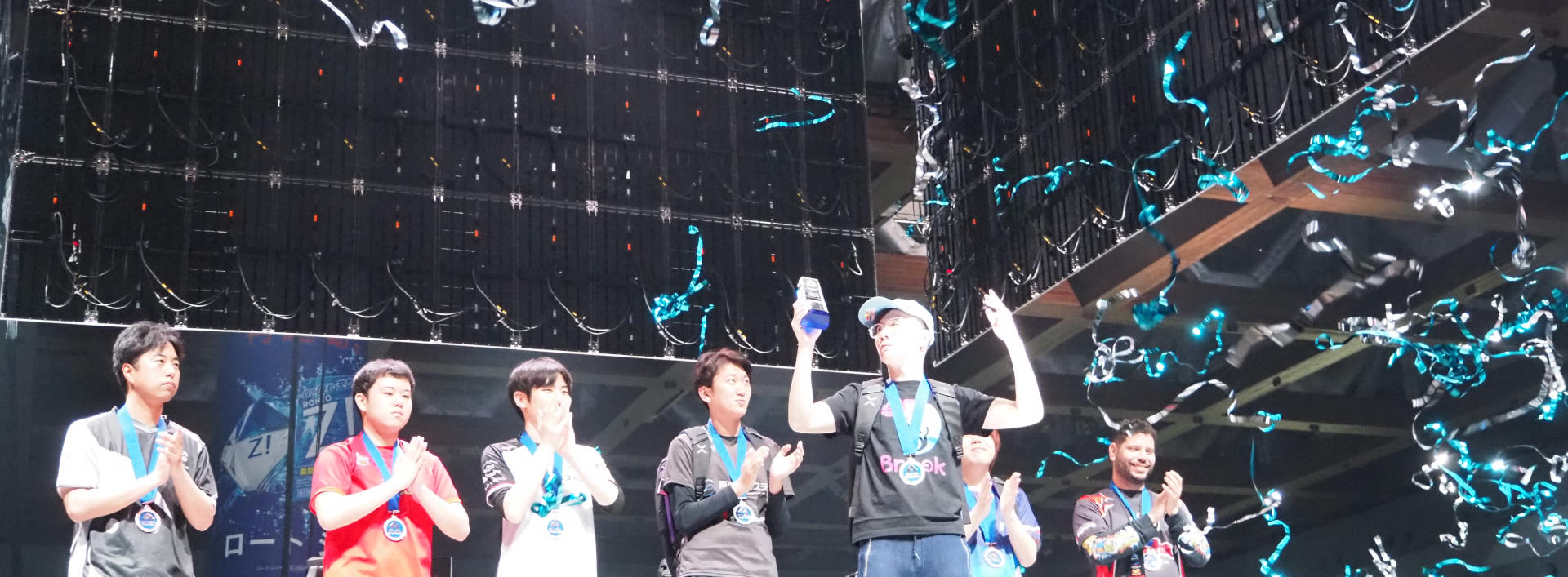Table of Contents
Capcom announced that they would release an Arcade Cabinet Version of Street Fighter V: Arcade Edition at the Japan Premiere. The audience was super excited about it. I’ve been living in Japan for the past 12 years or so, and had some thoughts on the announcement. I’ve been a big fan of street fighter since I first ran into it at a local Pizza Shop in West Windsor, New Jersey, and played a lot of Champion Edition, Super, and Super Turbo through college. Then I went off to grad school, and doing a PhD took up a lot of time, so I didn’t get to play much. I kind of missed SF3 more or less. I did have a summer internship in Japan where I played a bunch of Zero2 in the arcades, but I would only occasionally go down to China Town Faire in New York, and when I did I usually played Super Turbo. So I was out of the scene for a while.
When I moved to Japan, that was just when CapCom was running location tests for Street Fighter 4, and I went to one of those. It was great. I played a whole bunch online for years. I never knew about the scene there though because it isn’t obvious how you are supposed to learn where all the action is at. I would just go to my local arcade after work, and play there. When Street Fighter V came out, I got that and played online. In the past two years though, I heard on the Jump In Podcast about the Akihabara eSports Square offline local, and I realized that I wish someone had gathered up information about locals and arcades in English. So I started to do that. I also started to write blog posts about offline events happening in Tokyo, hopefully to help others find out what is going on. As a Street Fighter fan living in Japan, I’d like speculate a bit about what this announcement might mean.
1 Fighter’s Crossover -Akiba-
Fighter’s Crossover -Akiba- is the name of the weekly offline SFV event held at Akihabara eSports Square. It is run by kagecchi, a long time Street Fighter player turned organizer. This is the local that I generally go to – I am a family man, and one night a week is about the right pace for me. I like the location, the bar, and the friendly atmosphere. He had a series of tweets after the TGS announcement, which I’ll translate here.
アケの発表で俺がイースクでやってる対戦会が今後どうしていくのか、どうすみわけされるのか注目だみたいな意見が散見されるんだが、それだけ認知されたってことなんだろうね。
— かげっち / kagecchi (@kagecchi79) September 23, 2018
After the announcement of the Arcade version of SFV happened, I’ve seen a lot of people wondering what is going to happen with the eSports Square Akihabara weekly, and how will the various scenes co-exist together. Why are people only talking about that though?
I’ve said from the start that I started doing this because I wanted a place where we could all gather like the arcades, and if an arcade version came out and I could quit doing this I would like to stop. But if people would like for FCA to continue, then maybe I should continue FCA. However, things can’t just continue exactly like they are now, or we will just be reducing the competition pool and everyone will be worse off for it.
I’ve been thinking about it while I’m lined up here to get some Sushi, but I think it’s funny that people are comparing free events run by corporations to this private event that I run myself, it’s really got a lot of recognition now, lol. At any rate, I’m interested in what is going to happen with the competition between free events and the arcades, and how all that will play out.
I spoke briefly with him on Wednesday, the 26th, to get permission to translate these tweets, and see what he thought. There were some people on twitter hoping that FCA would continue, and after talking with him it sounds like that might happen, but really that is up to Kagecchi and other community members. FCA was one of the first (I wasn’t active in the scene then, so I don’t know for sure) regular SFV offline gatherings in Tokyo, and there are many beneficial things that have come out of it.
First, Kagecchi has always been interested in developing young players. For many of the younger players that are prominent now – specifically, Takeuchi John and Tachikawa – he would waive the house fee, in exchange for them helping out with setup / teardown. He also streams the FCA gathering on Twitch, and as part of that has helped younger commentators hone their craft. Recently, Nanai has been doing more commentary for Capcom Pro Tour Events that are simulcast in Japanese. Nanai came up through the FCA system.
The FCA layout is set up with dedicated setups for beginner and intermediate players, and one goal is to allow players of equal levels to find each other, meet, play, and develop their games together. Having decided setups and a system for segregating level of play makes it easier to find people that you can grow with.
Unlike most locals in America, the main focus of FCA is not on a weekly tournament. Each week there is usually a different event. They rotate between beginner and intermediate level tournaments (regulated by self reported LP), random three on three tournaments, and open entry standard tournaments. The open entry tournaments are FT1 single elimination, to bring back that “arcade feel” where you have just one coin. The random three on three tournaments are a great way to meet players of various levels, and open up conversations with them – which might sound odd, but in Japan people are hesitant to start up a conversation with someone they do not know.
Also, they have a bar that serves food, and I personally enjoy hanging out with friends, chatting, and drinking some wine when the setups are all busy. So while Kagecchi’s goal is to replicate the arcade feel and provide a location where people can come together to play, the environment is different from an arcade, and has been successful by other metrics as well.
2 Studio Sky
Studio Sky recently announced a transition to a new model. Previous to this, they had been a rental space that individuals rented out to set up events using the space. They are still continuing that offering, but are also trying to move to a model where Studio Sky will be open, for free, to people for eSports training and practice. Momochi and Chocoblanka have not yet announced how their business model for that will work, but I believe it will need to involve sponsorship of some kind, if they are not collecting a venue fee to cover the cost of the space. I suspect that under whatever model they work out – they are still doing this under a trial basis, and it might not succeed – they will probably continue to have SFV / DBFZ / other events at their space. It will be interesting to see how arcades offering up one of the major games will impact what they do though.
3 Red Bull Nakano Gaming Sphere
The Red Bull Gaming Sphere in Nakano has free events on various night, including a Thursday SFV event, spearheaded (as far as I can tell based on talking with him) Mago. Since Red Bull sponsors the event, and there is already no venue fee, I suspect this local will continue as well, unless participation drops off by a large amount. Given that it is free, I don’t think that is likely.
4 Shot Bar Lucy
Shot Bar Lucy is literally a bar, and they have a few PS4 setups. I haven’t been there yet, but I would like to go at some point. Given how Japan’s Gaming Bars are fighting for survival (this is a link to a great video by Super Bunny Hop, check it out if you have time, and check out his other stuff) I’m not really sure how Shot Bar Lucy has been getting along as it is. Since they are community run events, and the bar itself does not offer the software, I think that might be their loophole. I expect that they will keep doing things as well, particularly the Women’s only SFV gatherings that they hold sporadically (and the one Men’s only event they held too!) At any rate, I want to go there and get a drink with James Chen and Ultra David if they ever show up in Tokyo again. I believe they were the ones who were curious about Shot Bar Lucy when someone had that as their “sponsor” at EVO 2018.
5 What new audiences will arcades open up?
Arcades in America have been dying, despite the laudable efforts of some. Why have arcades lasted so long in Japan? Arcades are certainly on the decline here, but they are still hanging on. This piece by the Financial Times covers some broad strokes, with nice human element segments focusing on people. There has been a big decline – from about 44,000 Game Centers in the 1980s down to about 5000 now. That still sounds like a lot, compared to America though.
So who are the people that are going to arcades, and why do they do it? I’m just speculating here – I’m not a sociologist – but I have a few more points that were not covered in that Financial Times article. There are lots of “Salarymen” (business men) that go to arcades. Younger workers likely live in small one room apartments without room for a bed – they usually have a Japanese futon (not the sofa-frame thing you are thinking of, just a thin mattress) that they fold up and store away during the day. You often won’t have room for a nice gaming setup, so the larger viewlix cabinets are a big improvement.
Japanese people very rarely have friends come over to their houses. They are small, and just generally socially people vastly prefer to meet outside the house. So there is a social aspect to it as well.
A very broad, and hopefully not very accurate, generalization is that married Japanese life can be a bit lonely. The wife expects the husband to work hard and long hours, and open communication isn’t something that is commonly found in Japanese relationships. One common reason people say kabakura clubs get patronage is that Japanese workers want someone to listen to them talk, so I think there are also some men out there who would rather go to an arcade and play games rather than go home to play games where they might get pressure from their significant other. I hope this isn’t true for everyone, but I’m sure some people want to blow off some steam before going home, and it isn’t feasible to game as a family.
So adding SFV to the arcades opens up a different audience that might not be interested enough to seek out SFV locals, but continues to casually play fighting games or other games in the arcade. That’s great, because I like anything that allows more people to get involved in fighting games.
Aside from demographics, another huge benefit is that there will be a place that people can gather and play SFV in person outside of the major population centers. Tokyo and Osaka have regular SFV offline gatherings, but smaller cities and the countryside just do not have that as an option. It is net play or bust (netplay is generally pretty good in Japan though). It will be a boon to people that aren’t in the major city centers.
6 Non-arcade spaces are appealing to a different demographic as well
Personally, I really hope to see the locals that we have in Japan continue as they are. I spoke a bit about some of the interesting things that have happened at FCA – which I’m most familiar with. The Studio Sky and Red Bull locals are great too, I’m just not as familiar with them. I do know that Mago was giving feedback on beginner players at some of the Red Bull Events, and Studio Sky has done some lessons on how to improve, and even a few “English for Fighting Game players” lessons.
The environment themselves at these local events can attract different people than what you might see at the arcade. Traditionally, Japanese arcades are viewed as dark, smoky places, not particularly attractive to women. Japanese arcades usually have multiple floors, and the ground floor has lots of crane games, music and rhythm games, other large-sized “experience” games, and sometimes selfie machines. Those areas are used by couples on dates out for fun, and usually inviting spaces.
The fighting games are usually on a separate floor, machines have ashtrays (beware the “sonic ashtray” from a salty salaryman loss), and it is usually cramped, dark, and loud. Of course, not all places are like that, there are some arcades that are well known for their fighting games in particular, but I’m thinking more of the local arcade of no particular renown. An open, inviting large space is a different proposition. I know that I have seen more women come to the FCA events than I see in arcades, and I think that is great. This is again, a generalization, and there are always going to be excellent women in some arcades, but when I did frequent them (and I did, a lot, during the SF4 era) I didn’t see as much diversity as I do at the locals.
Finally, I really like that there is one day a week where I can go somewhere, and know that there will be other people going there so that I can find someone at my level, or watch some high level matches. Having that focus point helps gather more people than what you see if you have SFV available all the time at lots of arcades all over the place.
7 Final thoughts and a bit on the hardware
Based on some of the information Taito has put out, the cabinet will use NESiCAxLive2, which is an online distribution system that also enables online play. So you might end up playing online anyway. The hardware itself looks to be Taito Type X4, which is a windows hardware base. Capcom says that the hardware will also have USB ports so you can use your own controller, which would be a new addition to the Type X4 base as far as I know (which isn’t much!) Unfortunately, with a Windows base, I’m a bit concerned about how the driver situation will work. Capcom hasn’t said anything about what kinds of sticks will work – I’m hoping that they did some driver work themselves to allow use of PS4 compatible peripherals, because that would be a more stable single target to aim for than support for all windows capable USB HID peripherals. Given how long it took to get good support for sticks on the Windows SFV version as it is though, I’m not hopeful. I’m happy I am a stick player since the cabs will have their own sticks.
Finally, I saw this tweet and thought it brought up a good point. Because there was no SFV in the arcades, some people who stuck it out in the arcades probably played some other games. What will happen when SFV becomes available? I suspect people will still play other games, it was always common to hop around as you wait for your turn, but it will be interesting to see what develops.
アケにスト5が無いからKOF始めてくれた常連さんもいたりで本当に助けられてるから、アケ5は絶対いれる
— ケん (@KeN_0701) September 23, 2018
Ken says that because there wasn’t an arcade version of SFV, a lot of people started playing KOF and he’s really thankful for that.
Finally, no matter what happens, I’m really glad for all the fun times I’ve had at the various offline gatherings in Japan. I hope they continue, or adapt to become even better in the new landscape we’ll see with SFV in arcades! Much thanks to all the TOs out there for all their hard work.
by
Tags:



Leave a Reply